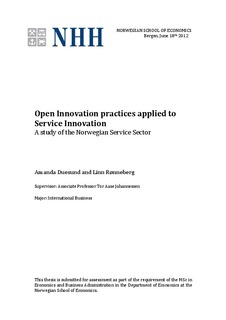Open innovation practices applied to service innovation : a study of the Norwegian service sector
Master thesis
Permanent lenke
http://hdl.handle.net/11250/169667Utgivelsesdato
2012Metadata
Vis full innførselSamlinger
- Master Thesis [4372]
Sammendrag
Open Innovation (OI) has become one of the most predominant topics in innovation
management. However, most literature has evolved around the effects and best
practices for product manufacturers. Nevertheless, service industries represent 60-70
percent of GDP in most western countries. Therefore, this thesis is motivated by a
desire to see how the practices of OI apply to this largely overlooked industry. The OI
concept involves going beyond company borders to include external inflows as well
as internal outflows, but also involves opening a company’s business model to
facilitate these flows. Firstly, the thesis examines the existing academic literature on
the topic. Thereafter, it analyzes the theoretical fit between OI practices and service
innovation, before studying whether OI practices are applicable to service innovation
in the six Norwegian case studies.
The findings show that theoretically OI is a valuable concept in service innovation,
due to the similarity of OI and service innovation practices. However, the empirical
findings indicate that OI practices within five of the companies are limited to external
inflows, whereas the sixth company that provides knowledge intensive services is
limited to internal outflows. The discoveries indicate that the incentives for internal
outflows are not obvious for management, and therefore this affects their likelihood of
adapting an open business model. Investments in OI management skills are absent in
all firms, resulting in the lack of acknowledgement towards the importance of having
a holistic perspective on innovation efforts. This is important because open innovation
will ultimately increase profit through alternative revenue streams. However, the
study shows that the lack of tradable intellectual property might inhibit the outbound
innovation processes in service firms. This emphasizes the importance of creating
more heterogenic service experiences for customer’s instead of standardized, which
are easier to imitate. To excel in open innovation, companies need to find their point
of differentiation, which will serve as their “protection mechanism”. The thesis
suggest that when a company has found their leverage point, they will no longer be
characterized by their fear of sharing new ideas, risk aversion, change reluctance and
dread of failure. The security of their leverage point will enable them to out-innovate
their competitors. Due to the unexplored nature of the concept, the study appeals for
future research in the field of open service innovation.
